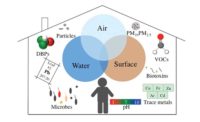What is the value of a healthy and productive human being in a building? If you go to work with a cold, work slowly, and perhaps infect your co-worker, how much money has your employer lost? What are the unseen influences of your office building, hospital room, classroom or home on your health and performance? Despite the facts that we all want to be robust and healthy (as well as comfortable) and we spend the vast majority of our time indoors, these questions do not have obvious answers.
Some aspects of building design and operation are obviously related to our health and are consequently rigorously regulated. For example, a landmark event in the history of hospital building codes was a tragic fire in the Hartford Hospital in 1961. A lighted cigarette, thrown into a trash chute, sparked a fire on the ninth floor that spread rapidly. Patients and staff were engulfed by intense heat and black smoke that poured through open doors. Before the fire could be contained, 16 people had perished, including patients, visitors, and medical staff.
The day after this horrendous fire, the hospital director required every staff member to walk through the disaster scene to understand how building characteristics had contributed to the rapid destruction of people and materials. Important fire safety lessons were learned, and mandatory building codes were rapidly integrated into hospitals nationwide.
This tragedy is a clear example of how building design impacted occupant safety. Many building related injuries, however, are much less immediate and obvious. One problem that is influenced by the built environment is the incidence of new infections in hospitalized patients, now referred to as healthcare-associated infections. The toll of these infections on life and budgets is difficult to calculate because reported numbers vary widely. Nevertheless, the rates are astronomical. The connections between healthcare-associated infections and hospital design, operation, and maintenance are obscure and hotly debated. Currently, most infection prevention strategies focus on human behavior such as hand hygiene while downplaying building design and maintenance. However, hospital facility managers realize that the built environment does contribute to the transmission of infectious microbes.
Hospitals are not the only buildings that contribute to health hazards. One only needs to do a quick internet search to be reminded of diseases associated with lead paint, asbestos, and radon exposure, to name a few.
What do we need to have a better understanding of the hidden building conditions associated with acute and chronic diseases? Do we have to wait for OSHA to discover a problem after many people have been harmed?
A preventive solution is to bring occupant health tracking into building performance metrics.
If we could create a real-time and usable database from measurements of occupant health and productivity, the building industry could understand the impact of design, operation, and exposure to building materials.
Collecting this data is more complicated than measuring things like fuel consumption and energy efficiency because metrics associated with health are more complex. Historically, health outcomes have been considered outside the expertise of the construction industry and have remained largely unmeasured and unregulated. Unfortunately, this lack of a clear connection has resulted in an economic stalemate. Without specific health metrics usable in the construction industry, real estate developers cannot demonstrate the “value” of design and maintenance choices associated with improved health and productivity. Meanwhile, the health costs of occupants in poorly designed buildings cannot be accurately assessed by investors and other stakeholders. This obscurity limits incentives to invest in health-based design as a strategy for competitive market differentiation.
To break this deadlock, the myth of a perceived tradeoff between building affordability and occupant health must be dispelled! This will only happen when we have reliable data to quantify the financial rewards of optimal health and productivity. With accurate tracking and disclosure of building related illnesses, we can implement primary prevention strategies and regulatory codes supported by knowledge of their specific health-related and financial impacts.
For businesses directly responsible for occupant health costs, such as with employer-based health insurance, the financial impact is even higher.
Like fire prevention statutes, these steps will dependably lead to indoor environments that actively promote health and maximize the overall value of buildings.





